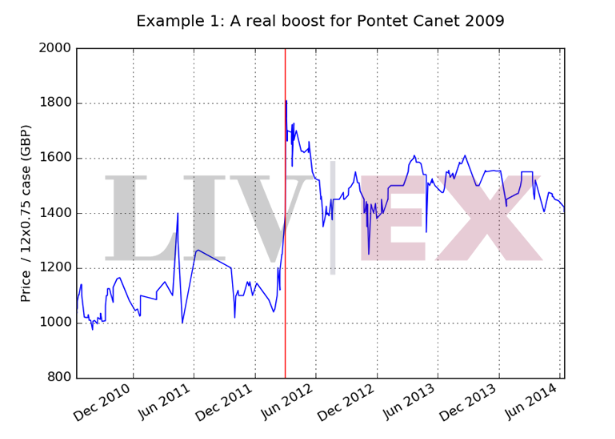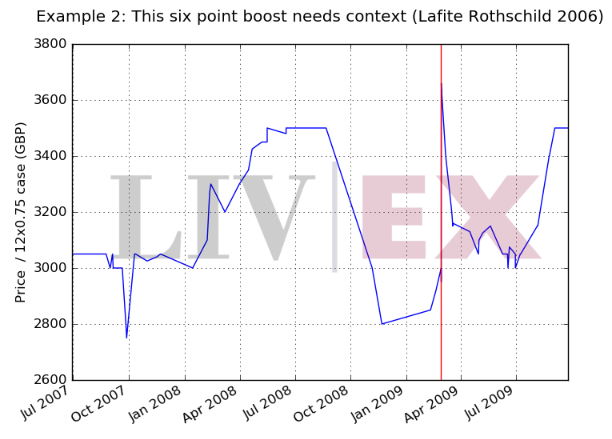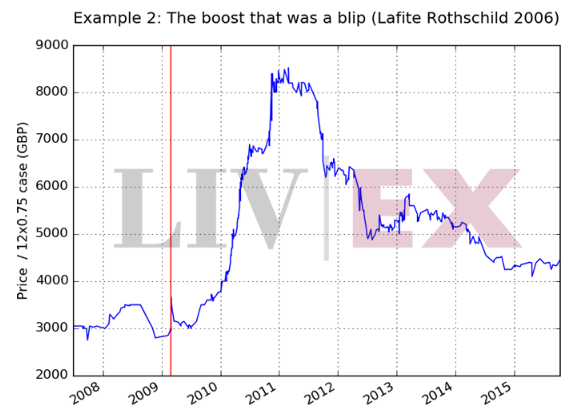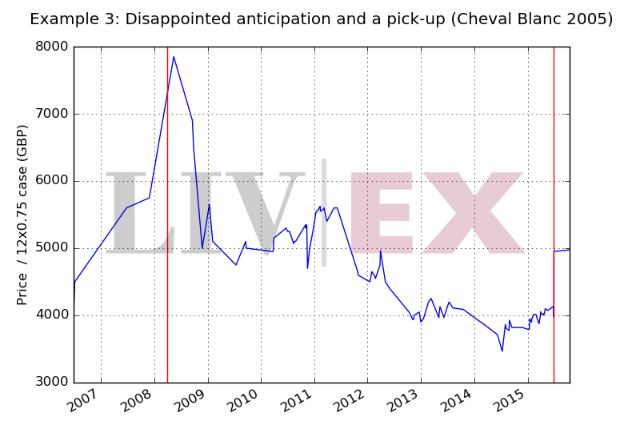Liv-ex has opened up the blog to Martin Klimmek (winequant.com). Martin is a Data Scientist who moonlights in the wine world. He is known in the financial mathematics community for work on model-independent pricing and hedging (Bruti-Liberati Prize 2012). Here he uses Liv-ex data to look at the historic impact of Robert Parker on the Bordeaux market, and explores whether price points might replace Parker points going forward.
Followers of this year’s En Primeur campaign will have noticed that release prices are creeping up again. What’s behind the upward creep?
In a previous post we saw that release prices have been stuck at elevated levels since 2011: after the heady bull-market for the 2009 and 2010 vintages, prices did not revert to pre-boom levels but got stuck somewhere in between.
You could say that the En Primeur system lost its innocence during the bubble years. Producers still remember a ballooning spread between En Primeur and London prices when the secondary market became red-hot.
The fear of regret is a powerful motivator. No producer wants to run the risk of leaving money on the table again, especially when a vintage feels right. The Wine Society has described the vintage in 2015 as “unquestionably the finest for the past five years.” Producers are aiming higher in case the vintage booms.
Apart from release price stickiness, there’s another reason we should not be surprised by the upward creep in prices: the wine market has lost a well established price signal. Parker’s handover of Wine Advocate tasting duties to Neal Martin marks the end of the era of the monolithic power critic. Consumers of top claret sympathized with Parker’s preference for concentrated, fruit-forward wines. Investors found his ratings helpful and easy to digest. Who or what will they turn to now? Will there be a Parker 2.0? Will vintage winners emerge from a cloud of digitally distributed vintage wisdom?
What would it take to assume the mantle? Let’s look at three examples of Parker’s unique ability to move prices in a market based on the elusive quality of good taste.
The Parker boost could be immediate and lasting. Here’s a chart of what happened to the Liv-ex market price when Parker upgraded his rating for 2009 Pontet Canet from 97 to 100 points (the date of the rating is indicated by the red line). Will anyone else be able to move the market like this again?
Parker helped indecisive buyers off the fence. A Parker upgrade made people willing to stick their necks out and say: “this wine is a winner.”
Let’s look at another example. In February 2009, Parker upgraded his rating of Lafite-Rothschild 2006 from 91 to 97 points. Prices on Liv-ex jumped 20% and the equivalent of 137 cases of Lafite changed hands on Liv-ex the following day.
The effect was immediate: available liquid was lapped up and more sellers entered the fray, competing to sell stock. Prices briefly touched old levels but quickly bounced back: the pre-Parker price level had become an elastic lower bound.
Granted, it’s easy to get carried away writing about Parker’s power. If we take a step back and zoom out in time, Parker’s influence appears as a blip on the radar: not even Parker can take credit for the incredible bull-market between 2010 and 2012. Larger forces were at play.
But suppose that Parker’s rating had been a disappointment. Would Lafite’s course through the bull-market have been less buoyant with fewer points?
Let’s look at an example where Parker points came in below expectations. In April 2008, Parker reduced the point range for Cheval Blanc 2005 from 96-100 to a definitive 96. This was his third rating of the wine after previous ratings in April 2006 and April 2007.
The trend had been upwards: 95-98 in 2006, 96-100 in 2007. The chart suggests investors had high expectations: a definite 100 was on the cards. But reality was four points short. After a gravity defying heroic purchase, the market-price began to decay.
With Parker’s spotlight shining elsewhere, the bull-market passed over this wine without leaving much of a trace. If it hadn’t finally received the expected 100 point rating in June 2015, market prices for Cheval Blanc 2005 may well have suffered further into 2016.
Parker’s influence came in a variety of flavors, from simple to subtle: his points could make a price jump immediately or they might ratchet up the lower bound on good value over time. A less favorable rating could set a ceiling on what investors were willing to pay.
The En Primeur market depends on trust, confidence and on stories that justify shifts in relative value. Sentiment is ultimately based on taste. Parker established a link between a tasting system and wine prices. It will take time for new signals to become established.
Until then the only familiar indicator of a wine’s quality is the price it can command in the market. It’s no surprise producers are aiming high.
[mc4wp_form id=”18204″]









